by Julie McConnell | May 2, 2013
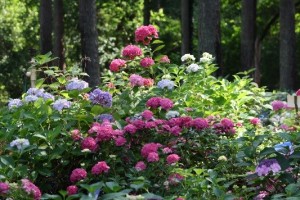
Hydrangeas
Bigleaf Hydrangea (Hydrangea macrophylla) are familiar faces in the southern shade garden. Although not originally from North America, they were introduced here over 200 years ago and perform well in the climate of the Florida Panhandle. Here are some quick tips about Bigleaf Hydranges.
- Hydrangeas prefer morning sun with afternoon shade or full shade and well-drained, moist soil
- The form is a mounding shrub that can have varying heights and widths, allow for a mature size on average of 6′ x 6′
- Hydrangeas have large green leaves that may be glossy or dull and are deciduous unless the winter is very mild
- There are two main flower types:mophead and lacecap
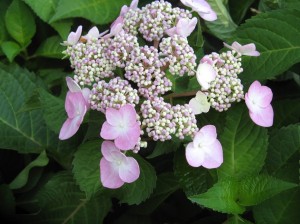
Lacecap Hydrangea
- Mophead flowers are rounded and usually composed of sterile flowers, with a few fertile flowers
- Lacecap flowers have sterile flowers on the outer edge of the circle, with fertile flowers in the center. When fertile flowers are fertilized they may turn a different color and the sterile flowers on the outer edge may invert themselves so they appear to be hanging down
- Flowers may be white, pink, purple, or blue; flower color is influenced by soil conditions and you may see multiple colors on the same plant!
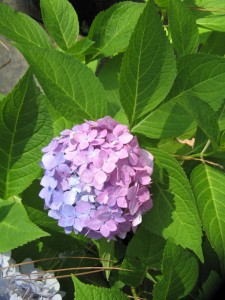
Penny Mac Hydrangea
- Bigleaf hydrangeas generally bloom on old wood, however, there are some types that will also bloom on new wood and fall into either “free-flowering” or “everblooming” categories. Free-flowering have flower buds on the tips of branches (old wood) and develop flower buds up and down the stem that flower after terminal (tip) buds flower. Everblooming hydrangeas form flower buds on the tips of both old wood and new wood and can flower throughout the season.
- If soils are sandy and infertile, add organic matter before planting
- Water as needed, especially during establishment phase (typically first year or two). Expect hydrangeas to wilt during hot summer afternoons, as with any plant check the soil moisture before irrigating to avoid overwatering
- Avoid overhead irrigation, leaf spot diseases and powdery mildew are more prevalent when foliage is wet for extended periods
- Prune after flowering, but before August when shaping is neededFor more information about long flowering hydrangea varieties see “New Hydrangeas for North and Central Florida: Bigleaf and Mountain Hydrangeas”
To learn more about influencing flower color and general care of hydrangeas read “French Hydrangea for Gardens in North and Central Florida.”
by Blake Thaxton | Apr 12, 2013

UF/IFAS NW District Extension agents and the UF/IFAS West Florida Research and Education Center have joined forces to provide relevant hands on training for the Small Farmers of northwest Florida and surrounding areas by developing the Gulf Coast Small Farms and Alternative Enterprises program. This Spring Field Day will be a sneak peek at what the program will offer in the coming months and years.
Join us to discover new production practices and opportunities for your small farm or fruit and vegetable gardens!
Topics and Demonstrations:
- Irrigation Practices
- Small Farm Integrated Pest Management
- Hydroponic Float Bed Lettuce
- Protected Agriculture
- Food Safety Issues for the Small Farm

Register here: Gulf Coast Small Farms & Alternative Enterprises
For more information please contact:
Robin Vickers at 850-393-7334 or rvickers@ufl.edu
Blake Thaxton at 850-623-3868 or bthaxton@ufl.edu
by Sheila Dunning | Apr 12, 2013
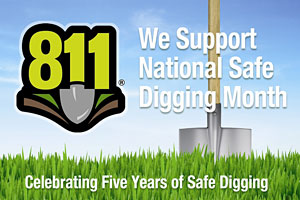 This month, recognized by the Senate and Florida’s governor, reminds diggers why calling 811 before all outdoor digging projects is important to your safety. Before installing a mailbox, fence, deck, garden or tree make sure to call Sunshine 811 to have underground lines marked. 811 is the free national number designated by the Federal Communications Commission. It notifies utility companies, who in turn send their professional locators to identify and mark the appropriate location of underground line with paint and flags in colors that identify the utility type. The following colors represent the seven various utilities: red – electric, orange – communications (telephone, cable tv), blue – potable water, green – sewer, yellow – gas, purple – reclaimed water, and white – site of intended excavation. To learn more about color designation and their corresponding utility go to: http://www.call811.com/faqs/default.aspx. Locate marks are good for 30 calendar days. Any work beyond that requires another call to 811. If the marks are destroyed before your project is done, stop digging and call 811.
This month, recognized by the Senate and Florida’s governor, reminds diggers why calling 811 before all outdoor digging projects is important to your safety. Before installing a mailbox, fence, deck, garden or tree make sure to call Sunshine 811 to have underground lines marked. 811 is the free national number designated by the Federal Communications Commission. It notifies utility companies, who in turn send their professional locators to identify and mark the appropriate location of underground line with paint and flags in colors that identify the utility type. The following colors represent the seven various utilities: red – electric, orange – communications (telephone, cable tv), blue – potable water, green – sewer, yellow – gas, purple – reclaimed water, and white – site of intended excavation. To learn more about color designation and their corresponding utility go to: http://www.call811.com/faqs/default.aspx. Locate marks are good for 30 calendar days. Any work beyond that requires another call to 811. If the marks are destroyed before your project is done, stop digging and call 811.
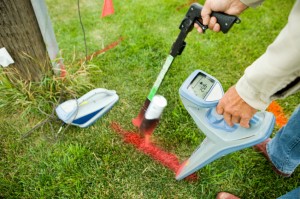
Hitting an underground utility line while digging can cause injuries, utility service outages to an entire neighborhood and damage to the environment. The depth of utility lines varies, and there may be multiple utility lines in one common area. Even if you think you know where an underground line is, time tends to change things. Erosion or tree roots can shift those utility lines. Failure to call before digging results in one unintentional utility hit every eight minutes nationwide. You could also be financially affected with costly fines and high repair costs.
The Common Ground Alliance (CGA) Damage Information Reporting Tool (DIRT) provides industry stakeholders with a way to anonymously submit data into a comprehensive database for analysis of the factors that lead to events. An event is defined by the CGA DIRT User’s Guide as “the occurrence of downtime, damages, and near misses.” The number of events submitted to DIRT for 2011 totaled 207,779. However, according to CGA DIRT “when a call is made to the one call canter (811) prior to excavation, 99% of the time there will be no damage”.
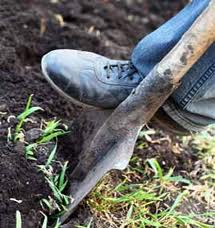
Calling 811 in Florida is the law. At least two full business days before digging, do-it yourselfers and professional excavators must contact 811 by phone to start the process of getting underground utility lines marked. This is a free service. Be sure that all utilities have been marked before grabbing the shovel. If you don’t see locate marks, don’t assume there are no underground utility lines. Verify with the Sunshine 811 Positive Response system. Follow up on your one call ticket by contacting 811 again on the third day. Sunshine State One Call is a not for profit corporation which began with the 1993 adoption of the “Underground Facility Damage Prevention and Safety Act,” Chapter 556, Florida Statutes. Online you can visit: www.online811.com, or call (800) 852-8057. If you provide a valid e-mail when requesting your locate ticket, positive response updates will automatically be sent to you when all utilities have responded. For more information on Florida’s law, visit www.Sunshine811.com.
by Mary Salinas | Mar 27, 2013
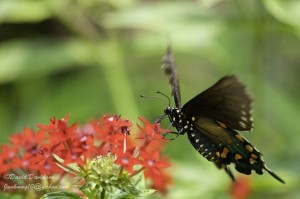
Photo courtesy of David Davidson
Butterflies are not only beautiful to look at in the landscape; they serve as important pollinators of fruiting plants. Attracting them to the garden and incorporating some features to get them to stay and reproduce involves advanced planning. Some steps to achieve butterfly garden optimization are outlined below.
- Choose a location that provides some protection from wind. Trees and shrubs that provide wind protection also serve as a safe harbor from rain and predators.
- The garden should offer both sunny and partially sunny environments.
- Ensure that any new plantings have access to a convenient irrigation source. A plentiful water source allows butterflies to be successfully established and maintained in good health.
Now plants need to be chosen. Adults feed on the nectar of many flowering trees, shrubs, perennials, and annuals. Fortunately, there are usually many choices that will meet diverse site requirements and varied taste preferences. In order to retain garden butterflies, certain plants need to be available to serve as host plants for their young. Here are a few hits to assist with this selection process.
- Determine which species of butterfly is common in a given geographical area. Most species have very few plants on which the caterpillars can feed, so host plants need to be chosen wisely.
- Determine whether any of the existing plants are host plants and if they are appropriate for a butterfly garden. For example, cassia is a host plant for the Cloudless Sulphur and citrus is a host plant for the Giant Swallowtail.
- In choosing nectar plants, select those that are native or Florida-Friendly as they are lower maintenance, and less troublesome in the long run.
- Choose plants that have flowers in a variety of color, size, and shape. Different butterflies like to feed at different elevations, so choose trees, shrubs, perennials, and annuals of varying heights.
- In order to have nectar available throughout the time when the butterflies occur, include plants that bloom at different times of the year. And include some plants that bloom all the time, like pentas or moss verbena.
Larger plants should be placed in the background with smaller plants layered in the foreground. When planting smaller annuals and perennials, place them in masses to better attract the butterflies. Consider placing host plants in an area that is in close proximity to the nectar plants, but in an area of your garden that is not a focal point. Host plants can get quite ragged looking from hungry caterpillars!
Good maintenance practices will enhance garden health. Regular fertilization, and as needed irrigation, will help keep garden plants in bloom and healthy – healthy plants are less susceptible to disease and pests. Avoid pesticides as they may harm butterflies and other beneficial insects. Never use a Bt or systemic pesticide since these target butterfly larvae. Lower risk oils or soaps are useful in treating localized insect infestations however. Lastly, be aware of beneficial insects that will help achieve satisfactory pest control.
Once the plants are placed there are several things to do to complete the butterfly garden.
- Add a spot where water can puddle on the ground for the adult butterflies to drink. They require minerals from the soil that get dissolved in the water.
- Also add a rock or log in a sunny spot where butterflies can rest and sun themselves.
- Consider placing a comfortable place for you to sit and enjoy the beauty of your garden and its inhabitants!
For more infortmation on butterfly gardening and for a plant list, please check out Butterfly Gardening in Florida
Enjoy the Butterflies !
by Blake Thaxton | Mar 13, 2013
Many landscape managers and home owners, especially on the gulf coast, wants to add the tropical feel to their landscape. The chief way to achieve this is by incorporating Palms and other tropical plants to their surroundings. Like with any other plant one would like to care for it properly. The improper care of Palms, I would like to blame on simple lack of “know how” and nothing else. Some palm care practices are a real problem in Northwest Florida; whether it is pruning, installing, or fertilizing. University of Florida has some great resources available on Palm care and maintenance. Let’s hit some highlights and use these tips to improve Palm care in northwest Florida.

First, installation is very important with Palms, as it is with all plants. One practice that ultimately results in death to a Palm is planting too deeply. Some have done this in the past to help secure the Palm from falling over. This may seem like a good idea but will harm the plant in many ways. Look at these two palms that were planted at the same time, see the difference?

Make sure when your planting to dig the hole twice as wide as the rootball and only as deep as the rootball is tall. Then for support build a supporting structure, but do not nail directly into the trunk (this will allow an entry point for disease). Once planted, water the palm in thoroughly, allowing for all the air pockets to be compromised If the fronds are tied up, untie them as soon as your palm is planted.

The next issue that faces palm lovers is pruning palms. Many prune a palm too much for a variety of reasons. Take a look at this palm for an example of a palm that has been pruned too much.

Follow the 9 to 3 clock rule, only pruning above the horizontal line of the crown of the palm. If you follow this rule you will generally be pruning correctly.

Read more about pruning, installing and general palm information for northwest Florida.
Photo Credits, University of Florida.














